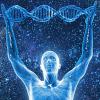NAD+ is a cellular compound found in every cell in the body and is essential to life. NAD+ enables the transfer of energy from the foods we eat to vital cell functions. It is also required to turn off genes that accelerate degenerative aging processes.
As NAD+ levels decline, mitochondrial function is impaired, resulting in fewer mitochondria surviving. This vicious cycle of mitochondrial depletion results in many of the physical symptoms of aging.
The reason for NAD declining is simple - its destroyed by CD38. As we age CD38 levels rise, and CD38 directly destroys NAD+, crippling many biological functions in the process.
https://www.ncbi.nlm...les/PMC4911708/
Here we demonstrate that expression and activity of the NADase CD38 increase with aging and that CD38 is required for the age-related NAD decline and mitochondrial dysfunction via a pathway mediated at least in part by regulation of SIRT3 activity. We also identified CD38 as the main enzyme involved in the degradation of the NAD precursor nicotinamide mononucleotide (NMN) in vivo, indicating that CD38 has a key role in the modulation of NAD-replacement therapy for aging and metabolic diseases.
The question here is WHY does CD38 rise as we age and how can we address it?
First of lets try to understand the function of CD38. What does it do in the body? As it turns out CD38 seems to be an integral part of the body's immune response to pathogens and cancer.
https://en.wikipedia.org/wiki/CD38
CD38 (cluster of differentiation 38), also known as cyclic ADP ribose hydrolase is a glycoprotein[5] found on the surface of many immune cells (white blood cells), including CD4+, CD8+, B lymphocytes and natural killer cells. CD38 also functions in cell adhesion, signal transduction and calcium signaling.[6]
CD38 is expressed by macrophages, one of the body's most important immune cells. Macrophages are a type of white blood cell, of the immune system, that engulfs and digests cellular debris, foreign substances, microbes, cancer cells, and anything else that does not have the type of proteins specific to healthy body cells on its surface in a process called phagocytosis.
High CD38 levels are markers for inflammation, disease and cancer.
The reason CD38 is a marker for these phenomena is that anytime there is pathogens, disease or cancer the body sends immune cells such as macrophages to address the situation and those immune cells express high levels of CD38.
https://www.frontier...2018.01593/full
CD38 Is Robustly Induced in Human Macrophages and Monocytes in Inflammatory Conditions
Finally, monocyte analyses in systemic lupus erythematosus patients revealed that, while all monocytes express CD38, high CD38 expression in the non-classical monocyte subpopulation is associated with disease. These data are consistent with an inflammatory marker role for CD38 in human macrophages and monocytes.
So we know that CD38 is part of the immune system and is expressed by disease fighting immune cells. So, severely inhibiting CD38 may have negative consequences for immunity and may not be the smartest approach to rising CD38 levels as we age.
CD38 levels rise as immune response rises and thus CD38 levels correlate with pathogen levels. So then WHY do CD38 level rise as we age?
Another to consider: As we age the thymus slowly degrades, beginning at age 20 and by age 50 nearly 80% of the thymus is lost. That means fewer T cells and an immune system that is crippled relative to the immune system of a 20 year old.
[cont in next post]































 This topic is locked
This topic is locked















